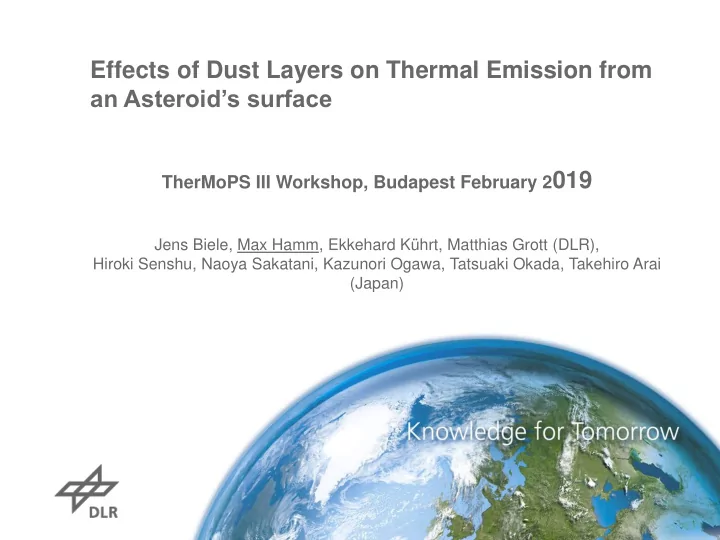

Effects of Dust Layers on Thermal Emission from an Asteroid’s surface TherMoPS III Workshop, Budapest February 2 019 Jens Biele, Max Hamm, Ekkehard Kührt, Matthias Grott (DLR), Hiroki Senshu, Naoya Sakatani, Kazunori Ogawa, Tatsuaki Okada, Takehiro Arai (Japan)
www.DLR.de • Chart 2 > Lecture > Author • Document > Date Effect of a thin dust layer on top of a homogeneous regolith or bedrock • Even though small asteroids hardly keep fines of impact ejecta or seismic shakings, a thin layer of dust covering coarser pebbles or bedrock surfaces is probable. Reason: Micrometeorite impacts and solar wind sputtering, thermal cracking • Fines can adhere to >> larger particles: granular bond number (vdW/weight) >1 for particles < 0.1 m (conservative) • It is well known (Paige+ (1994), Putzig+ (2007)) that a relatively thin layer of low TI material can “mask” the presence of high TI material below .
www.DLR.de • Chart 3 > Lecture > Author • Document > Date 2layer model dust, Γ =25 tiu δ Porous rock, Bedrock, Γ Γ =300 tiu =1280 tiu z
www.DLR.de • Chart 4 > Lecture > Author • Document > Date Application to MARA observation site, Ryugu, Oct. 3, 2018 • cp=700 J/kg/K, ε =0.90, A=0.0178, latitude -34.6 ° (subsolar latitude -5.3 ° ) • Then we run a 2-layer model: • dust (k=0.0025 W/m/K, ρ =366 kg/m³ TI=25) of varying thickness δ • overlaying a semi-infinite layer of bedrock (k=1 W/m/K, ρ =2000 kg/m³, TI=1180) • or porous rock (k=0.0866 W/m/K, ρ =1480 kg/m³, TI=300), • determine the lag angle as function of δ and compute the „ effective “ TI corresponding to this lag but for a homogeneous material • Effective TI was also computed according to a fit to the T-curve (only day or day+night) and by comparing Tmin, Tmax to the values for homogeneous surface
www.DLR.de • Chart 5 > Lecture > Author • Document > Date Calibration: lag, Tmax, Tmin, homogeneous
www.DLR.de • Chart 6 > Lecture > Author • Document > Date Comparison 1layer 2layer
www.DLR.de • Chart 7 > Lecture > Author • Document > Date Effect of dust thickness on lag, Tmax, Tmin
www.DLR.de • Chart 8 > Lecture > Author • Document > Date Description of the effect of a 2 layers • With increasing δ , daytime temperature curve quickly becomes similar to that of the low-TI top layer, i.e. small thermal lag, high Tmax, symmetric, STM-like dayside T curve • The bottom layer shows up shortly after sunset (cooling curve), when the fast cooling rate suddenly becomes much less steep and the minimum temperature is much higher than for the homogeneous top layer. • „ Effective “ thermal inertia (of a homogeneous model) can be very different depending on what is considered: lag, Tmin, Tmax or a global fit to the T- curve (diurnal/only day/only night) • For top layer depths 0.1 .. 1 diurnal thermal skin depth we find lag angles LESS (almost 0) than possible for the homogeneous top layer material, i.e. a minimum! • For small top layer depths d, we find 1/lag=1/lag0+a*d+b*d².
www.DLR.de • Chart 9 > Lecture > Author • Document > Date Fit error 2layer fitted to 1layer
www.DLR.de • Chart 10 > Lecture > Author • Document > Date Result: effective k and TI as a function of δ
www.DLR.de • Chart 11 > Lecture > Author • Document > Date Comparison of effective TI (homogeneous) curve with 2layer curves: some examples
www.DLR.de • Chart 12 > Lecture > Author • Document > Date Conclusions • For Ryugu, we see no indications for any appreciable dust layer on the surface of the rock observed by MARA. MasCAM images indicate no fine particles, just boulders and rocks (Jaumann, Schmitz et al. 2019). • The MARA diurnal curve can be well explained by a homogeneous Γ, also there is no “kink” discernible at sunset (Grott, Knollenberg et al. 2019). The night portion of the observed brightness temperature has a root-mean-square deviation of <0.5K to the 1-layer model fit with J m -2 K -1 s -1/2 , which is consistent with a dust layer thickness of <40µm. • Thus, there is no dust on the rock surface in the MARA FoV on Ryugu, i.e. fines smaller than the MasCAM resolution of 0.3x0.8 mm². Dust thicknesses of >0.1mm would be definitely seen as a distortion of the diurnal surface temperature curve.
www.DLR.de • Chart 13 > Lecture > Author • Document > Date Summary • Investigated the influence of thin opaque dust layers on the thermal emission of rocks and regolith • Determined the thermal response of these dust-covered surfaces to diurnal insolation cycles • Compare our simulations to the observations by the MARA radiometer on Hayabusa2/MASCOT target asteroid (162173) Ryugu • Even a very thin (10..100µm) fine- grained very porous layer (“dust”) with thermal inertia Γ of ~25 J m -2 K -1 s -1/2 on top of a material with Γ of ~300 or 1300 J m -2 K -1 s -1/2 can have a significant effect on the diurnal surface (brightness) temperature curves and alter, in cases, by more than 20%, the “effective TI” (derived under the ”simple model” assumption of a homogenous surface material). • The masking of the underlying material is complete at ~1 diurnal skin depth (~10 mm) of dust thickness. • Considering that the observed MARA diurnal curve can be fitted very well with a homogeneous surface (Grott et al., submitted to Nature, 2019) and given the context in situ camera observations (Jaumann et al., submitted to Science, 2019) we can place strong constraints on the putative dust layer (with grain sizes smaller than the camera resolution) on the observed boulder on Ryugu.
www.DLR.de • Chart 14 > Lecture > Author • Document > Date Thank you for your attention!
Recommend
More recommend